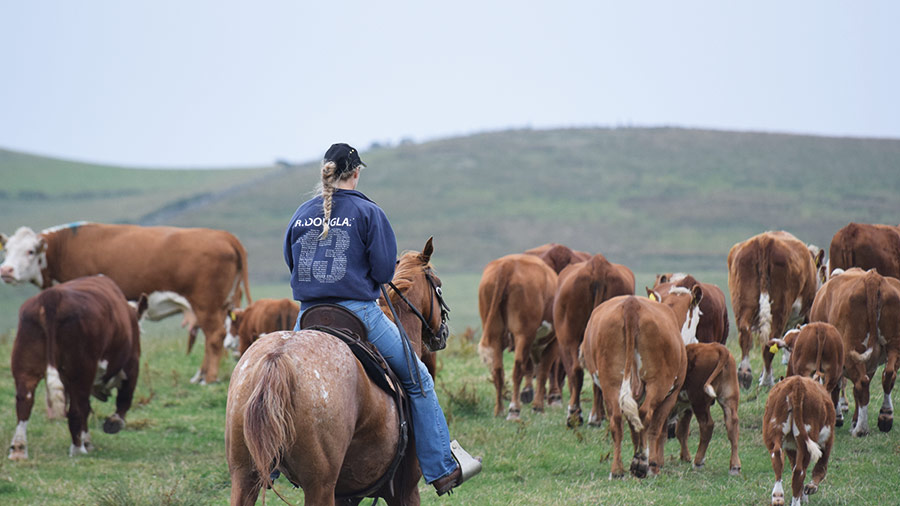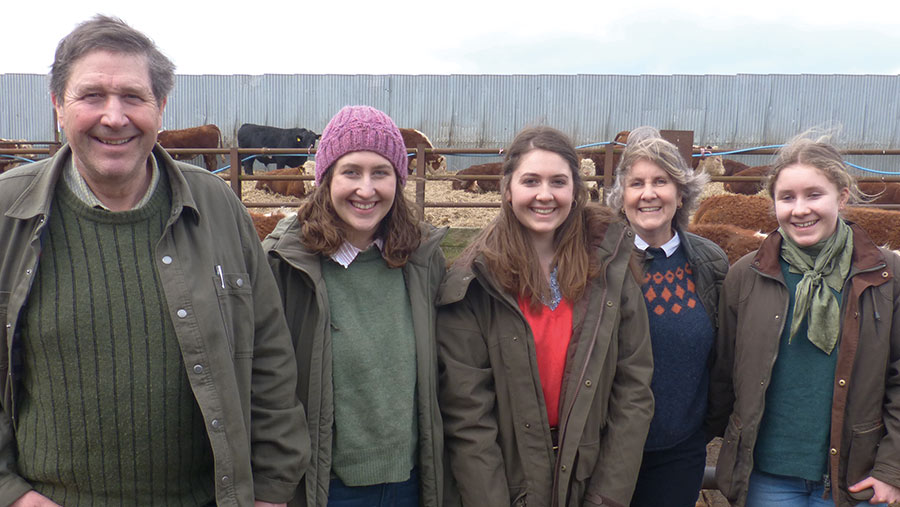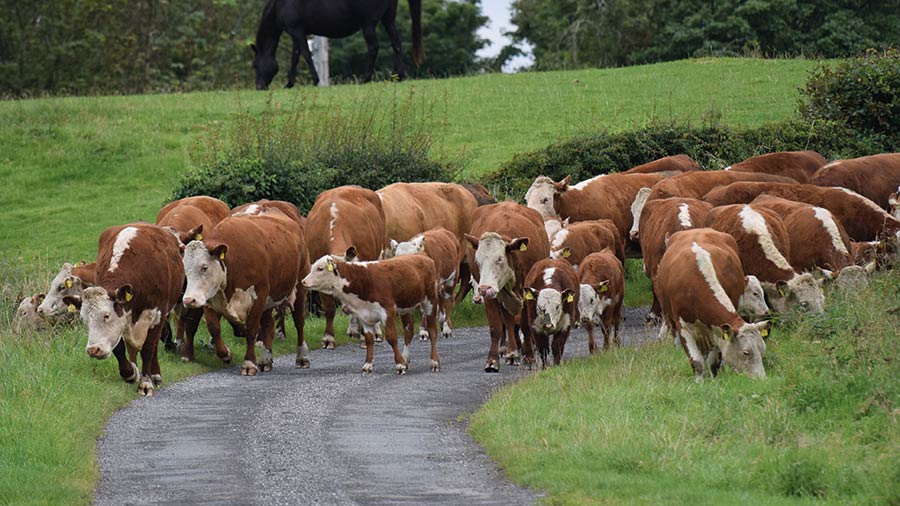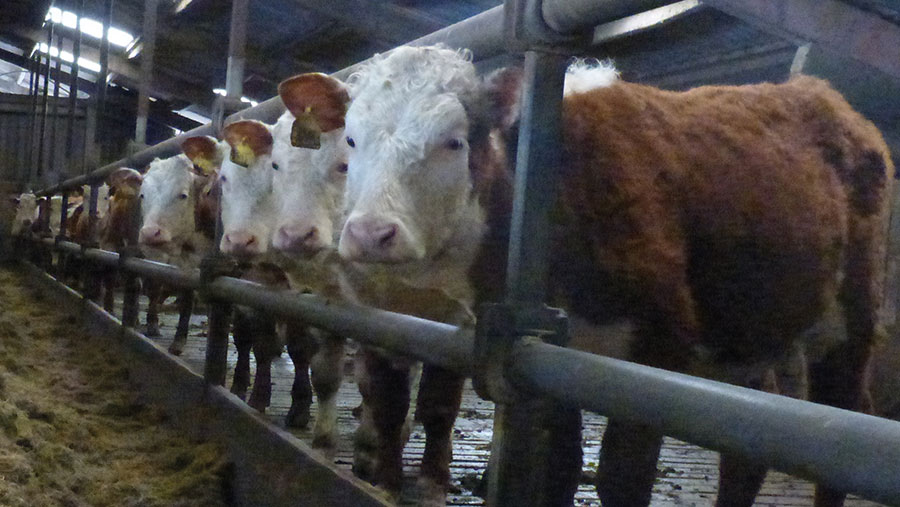Hereford herd grows demand with line-bred US genetics
 © Ervie Herefords
© Ervie Herefords A Scottish Hereford herd has seen bull sales grow four-fold since introducing line-bred US genetics selected for high yearling weights on the Montana rangelands.
The Douglas family at Ervie Herefords, Mains of Airies, Stranraer, first imported Line One Hereford (see “What are Line One Herefords?”) embryos in 2005.
Back then, the farm would typically sell 15-20 bulls a year, mainly to dairy farms looking for short-gestation, easy-calving bulls that were good on their feet.
See also: 5 tips on selecting and breeding beef replacements

John, Ellen, Olivia, Alexandra and Ellen Dougals © MAG/Michael Priestley
But now Ervie Herefords sells about 25 bulls into commercial and pedigree suckler herds and more than 50 to dairy farms.
John and Alexandra Douglas believe Line One genetics, as well as the farm’s unwavering focus on low-input, forage-fed cows, have caught breeders’ attention.
Farm facts
- 242ha (600 acres) grassland (mostly ploughable)
- 140 pedigree-registered Herefords
- 24 pedigree Aberdeen Angus cows
- Medium to light loam land
- Pure Texel and Romney flock, running 500 sheep in total (held a major reduction sale last year)
- Sells bulls on-farm through February bull sale and privately thereafter
- More than 1,000mm of rainfall a year
- Family labour, plus a farmhand three days a week
Importing Line Ones
The family’s interest in Line One genetics started back in 2004, when Mr Douglas attended the World Hereford Conference in Australia and saw several large herds with Line One influence.
After doing some reading and going to the 2005 Denver stock show, he got to know Jack Holden of Holden Herefords, who marketed his cattle as “Line One-bred”.
By working with US ranchers who bought cattle from the Line One sale in Montana, Mr Douglas imported the closely bred cattle to breed easy-fleshing cows that achieved good performance from low birthweights.
Since then, Mr Douglas has imported embryos three times from Holden Herefords (2005, 2008 and 2021), three times from Gerald Beran and Vince Dolecheck, Kansas (2007, 2009 and 2014), and once from the Cooper Hereford ranch in 2008.
All three herds have been influenced by Line One genetics.
“Travelling to Montana and viewing the Holden and Cooper herds motivated me to replicate how they operated, but in our temperate British climate,” explains Mr Douglas.
“I was also convinced to operate and market my cattle completely unconnected to and unaffected by the show ring, with selection traits in line with commercial, low-cost beef production.”
Impact of Line Ones
Line One genetics have increased herd uniformity and eradicated any occasionally large calves and difficult calvings.
Most calves are born weighing 39-42kg, with 45kg typically being the heaviest the farm sees.
“Before, when we used artificial insemination to introduce bloodlines, we would find that many bulls would produce some big calves requiring assistance and that they were not reliable for that trait,” says Mr Douglas.
“Unless a cow has a breach presentation, we do not expect to have to assist her.”
They are genetically so different to other Herefords, US ranchers can use them as an outcross on pure Herefords or use them in a cross-breeding programme for more heterosis (hybrid vigour) – such as with Angus for a Black Baldy.
Because the line-bred genetics are 32% inbred, this tends to suppress growth and yearling weight slightly on individuals in the Ervie herd.
However, the end goal is for customers to buy Line One stock and capitalise on it by increasing heterosis on their own farms.
“That is what we rely on for sustained support from our repeat customers and it is what has brought us the customer base we have. We are not in it for a quick profit: our business must be long-term.”
Ervie Herefords: The system

© MAG/Michael Priestley
Breeding strategy
- Bulls are only used in one tribe for one, two or possibly three seasons. Five-cow tribes (families) help manage inbreeding. A bull is only ever used on the next tribe along – for example, a bull from tribe one is used on tribe two.
- Bulls are often sold at four or five years old after use in the herd.
- Scrotal size estimated breeding value (EBV) is important for bulls, as is 400-day weight.
- Female selection is guided by 200-day weights.
- The herd is bred for tight udders and small teats to help young calves suckle.
- A balanced approach is taken to milk EBVs, as too much milk can result in difficulties in rebreeding, and lameness is culled – the foot-trimmer has trimmed only one animal in the past four years.
- Everything is bred to natural service.
Calving
- Everything calves outside from early May for 63 days.
- This year, the herd calved in two groups – heifers (calving at two years) and three-year-olds, and everything else.
- Cattle are set-stocked during calving and with calves.
Youngstock
- Calves are dehorned and vaccinated after silaging in mid-June and cows are put into bulling groups.
- Calves are not creep-fed at all and are weaned into buildings in November.
- Heifers and bulls are wintered on silage and 1.5kg a head a day of wheat and sugar beet pulp and rolled barley. Heifers are housed in a slatted shed.

© MAG/Michael Priestley
Wintering
- This year, cows have been fed silage on a sacrifice field earmarked for resowing in the spring.
- Previously, cows were wintered on kale, but that’s no longer necessary as last year a reduction sale sold almost half the herd.
- Cows and in-calf heifers are outwintered, with only silage and minerals given to assess their true performance.
What are Line One Herefords?
Line One Herefords are extensively managed line-bred cattle that have been selected for yearling weight in a low-input system in a research herd in Montana since 1934.
The herd is managed by the US Department of Agriculture at Fort Keogh, Montana.
Line One was one of 10 lines to be studied in the 1930s and 1940s, with the original idea of crossing inbred lines for commercial production coming from hybrid corn.
The result has been extremely hardy and fertile cattle offered for sale to commercial US ranches.
The herd currently numbers 70 cows plus followers and is about 32% inbred.
What is line breeding?
Line breeding is highly strategic inbreeding with a goal of maintaining a high relationship to an outstanding ancestor while keeping inbreeding as low as possible.
To manage risk of deleterious recessives (birth defects etc), inbreeding is calculated through a computer system to limit the generational increase in inbreeding to less than 5% per generation. Importantly, the line proved to be very safe for recessives and genetic abnormalities over time.
The Line One foundation sires were Advance Domino 20 and 54, both sons of Advance Domino 13, who was a son of Prince Domino, a noted Hereford sire from the early 1900s.
The initial crossing was of daughters of Advance Domino 20 with his half-brother Advance Domino 54 and vice versa.
- Location 22,258ha (55,000-acre) ranch near Miles City, eastern Montana.
- Environment Highs of 40C-plus in summer and -40C in winter, and less than 320mm of rain/year.
- Management Cows graze rough, unimproved rangeland extensively at 12-14ha (30-35 acres) a cow, and calve outside in April and May after a 50-day breeding season with minimal intervention. Heifers calve in a feedlot and cows in a sheltered riverside area.
- Performance The herd achieves an 85% in-calf rate and aims for less than 5% mortality in a kind year. By comparison, the cross-bred cattle on the ranch typically hit 90-92% in-calf rates.
Source: Dr Tom Geary, USDA, and Dr Michael MacNeil, Delta Genetics
